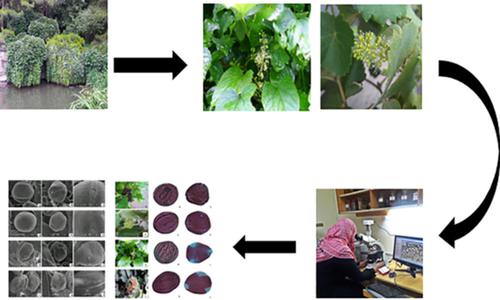当前位置:
X-MOL 学术
›
Microsc. Res. Tech.
›
论文详情
Our official English website, www.x-mol.net, welcomes your
feedback! (Note: you will need to create a separate account there.)
Application and implication of scanning electron microscopy for evaluation of palyno‐morphological features of Vitaceae from Pakistan
Microscopy Research and Technique ( IF 2.0 ) Pub Date : 2020-10-16 , DOI: 10.1002/jemt.23619 Lubna 1 , Muhammad Zafar 1 , Mushtaq Ahmad 1 , Ghulam Mujtaba Shah 2 , Amir Muhammad Khan 3, 4 , Omer Kilic 5 , Erkan Yilmaz 5 , Fethi A Ozdemir 6 , Muhammad Ishtiaq Ali 7 , Muhammad Ajmal Shah 8 , Shazia Sultana 1 , Shabir Ahmad 1
Microscopy Research and Technique ( IF 2.0 ) Pub Date : 2020-10-16 , DOI: 10.1002/jemt.23619 Lubna 1 , Muhammad Zafar 1 , Mushtaq Ahmad 1 , Ghulam Mujtaba Shah 2 , Amir Muhammad Khan 3, 4 , Omer Kilic 5 , Erkan Yilmaz 5 , Fethi A Ozdemir 6 , Muhammad Ishtiaq Ali 7 , Muhammad Ajmal Shah 8 , Shazia Sultana 1 , Shabir Ahmad 1
Affiliation

|
The present study aimed to investigate the palyno‐morphological features of species of family Vitaceae from Pakistan. A total of nine species, belonging to four genera were collected, pressed, identified, and then analyzed microscopically. Both quantitative and qualitative characters of the pollen grains were recorded including polar and equatorial diameter, P/E ratio, number of colpi and pores, exine thickness and shapes of the pollen in both polar and equatorial view, and exine sculpturing using Leica microscope fitted with camera Meiji Infinity 1 and then analyzed statistically using software IBM SPSS Statistics 20. The results of the present study demonstrated the variations in polar and equatorial diameter, exine thickness, P/E ratio, pollen shape, and exine sculpturing of the studied species and highlighted the significance of pollen morphology as an identification tool. The present study may contribute to better understand the classification at genus level, which will support the future phylogenetic characterization of the family.
中文翻译:

扫描电镜在巴基斯坦葡萄科孢粉形态特征评价中的应用及意义
本研究旨在调查巴基斯坦葡萄科植物的孢粉形态特征。共收集、压榨、鉴定和显微分析了属于四个属的九个物种。记录了花粉粒的定量和定性特征,包括极地和赤道直径、P/E 比、菌落和孔数、花粉在极地和赤道视图中的外壁厚度和形状,以及使用装有显微镜的徕卡显微镜进行外壁雕刻。相机 Meiji Infinity 1 然后使用软件 IBM SPSS Statistics 20 进行统计分析。 本研究的结果证明了极地和赤道直径、外壁厚度、P/E 比、花粉形状、和所研究物种的外壁雕刻,并强调了花粉形态作为识别工具的重要性。本研究可能有助于更好地理解属水平的分类,这将支持该科未来的系统发育特征。
更新日期:2020-10-16
中文翻译:

扫描电镜在巴基斯坦葡萄科孢粉形态特征评价中的应用及意义
本研究旨在调查巴基斯坦葡萄科植物的孢粉形态特征。共收集、压榨、鉴定和显微分析了属于四个属的九个物种。记录了花粉粒的定量和定性特征,包括极地和赤道直径、P/E 比、菌落和孔数、花粉在极地和赤道视图中的外壁厚度和形状,以及使用装有显微镜的徕卡显微镜进行外壁雕刻。相机 Meiji Infinity 1 然后使用软件 IBM SPSS Statistics 20 进行统计分析。 本研究的结果证明了极地和赤道直径、外壁厚度、P/E 比、花粉形状、和所研究物种的外壁雕刻,并强调了花粉形态作为识别工具的重要性。本研究可能有助于更好地理解属水平的分类,这将支持该科未来的系统发育特征。









































 京公网安备 11010802027423号
京公网安备 11010802027423号